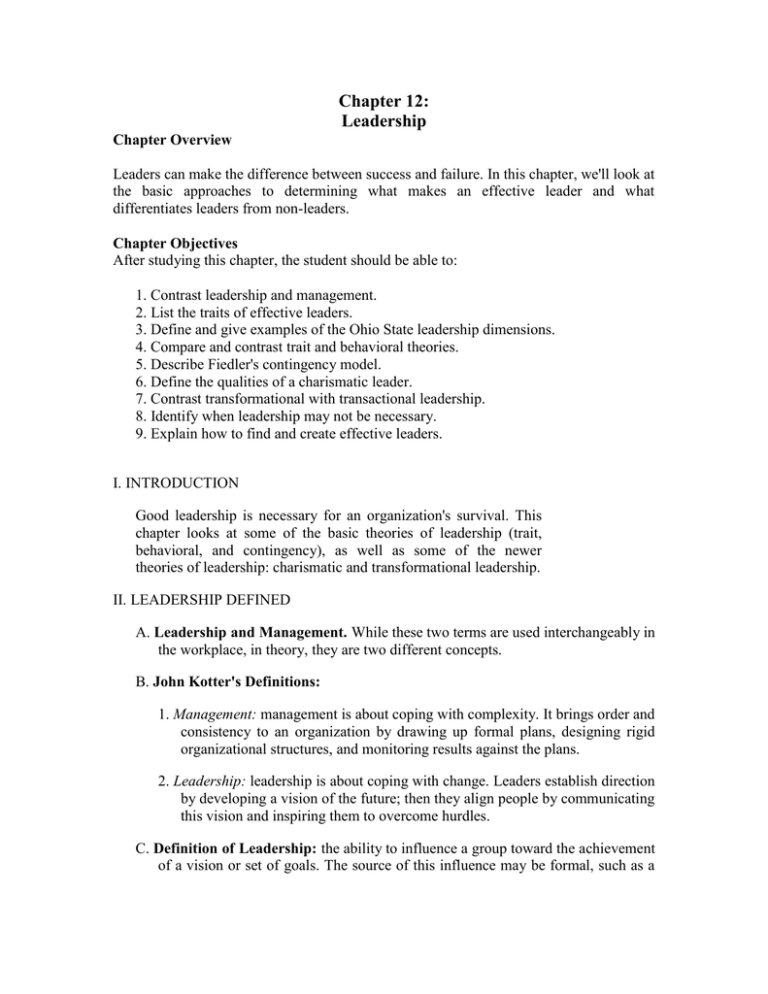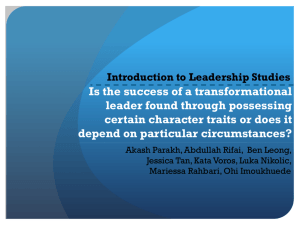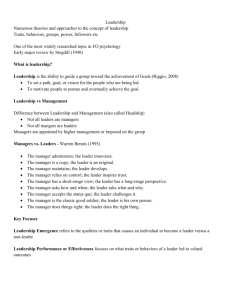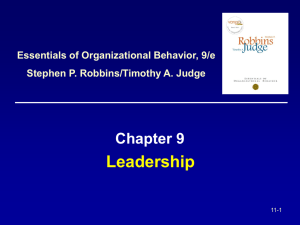Chapter 12-Leadership Handout
advertisement

Chapter 12: Leadership Chapter Overview Leaders can make the difference between success and failure. In this chapter, we'll look at the basic approaches to determining what makes an effective leader and what differentiates leaders from non-leaders. Chapter Objectives After studying this chapter, the student should be able to: 1. Contrast leadership and management. 2. List the traits of effective leaders. 3. Define and give examples of the Ohio State leadership dimensions. 4. Compare and contrast trait and behavioral theories. 5. Describe Fiedler's contingency model. 6. Define the qualities of a charismatic leader. 7. Contrast transformational with transactional leadership. 8. Identify when leadership may not be necessary. 9. Explain how to find and create effective leaders. I. INTRODUCTION Good leadership is necessary for an organization's survival. This chapter looks at some of the basic theories of leadership (trait, behavioral, and contingency), as well as some of the newer theories of leadership: charismatic and transformational leadership. II. LEADERSHIP DEFINED A. Leadership and Management. While these two terms are used interchangeably in the workplace, in theory, they are two different concepts. B. John Kotter's Definitions: 1. Management: management is about coping with complexity. It brings order and consistency to an organization by drawing up formal plans, designing rigid organizational structures, and monitoring results against the plans. 2. Leadership: leadership is about coping with change. Leaders establish direction by developing a vision of the future; then they align people by communicating this vision and inspiring them to overcome hurdles. C. Definition of Leadership: the ability to influence a group toward the achievement of a vision or set of goals. The source of this influence may be formal, such as a person's managerial rank in the organization, or an informal (non-sanctioned) ability to influence that arises outside the formal structure of the organization. D. The Need for Both. Organizations need both strong leadership and strong management for optimal effectiveness. While a good leader may tell the organization where to go, it still takes good managers to ensure they get there in one piece. III. TRAIT THEORIES A. Background. Trait theories of leadership differentiated leaders from non-leaders by focusing on personal qualities and characteristics. As one of the earliest forms of leadership study, trait theories searched for any personality, social, physical or intellectual factors that could describe leaders and differentiate them from nonleaders. This initial stream of research proved to be relatively unproductive. B. The Big Five Personality Framework and Trait Theory. When the existing trait theory research was organized around the Big Five personality framework (extroversion, agreeableness, conscientiousness, emotional stability, and openness to experience) a clearer picture began to emerge. 1. Extroversion. Two of the most common traits of leaders, ambition and energy, are part of the definition for extroversion. This is one of the most important traits of effective leaders and separates them from non-leaders. 2. Conscientiousness and Openness to Experience. These two Big Five traits also showed strong and consistent relationships to leadership, although not as strong as extroversion. 3. Agreeableness and Emotional Stability. These last two Big Five traits were not strongly correlated with leadership. 4. Key Common Traits. Using the Big Five framework, leaders do appear to have key traits in common: they are extroverted (individuals who like being around people and are able to assert themselves), conscientious (disciplined individuals who keep the commitments they make), and open (individuals who are creative and flexible). C. Emotional Intelligence (EI) and Trait Theory. The key component of emotional intelligence for leaders appears to be empathy. Empathetic leaders can make sense of other's needs, listen to what followers say (and don't say), and are able to read the reactions of others. This trait may inspire followers. Research on this point is both light and inconclusive. D. Trait Theory Summary. 1. Predictive Ability. While the individual traits themselves did not prove to be predictive, using the Big Five personality framework does tend to show that traits can separate leaders from non-leaders. 2. Leadership Success. While traits do differentiate leaders from non-leaders, they do not distinguish between effective and ineffective leaders. Merely possessing the correct traits do not make a leader automatically successful. IV. BEHAVIORAL THEORIES A. Background. As a result of the presumed failures of early trait studies, researchers from the 1940s through the 1960s began studying behaviors exhibited by leaders as a means to separate leaders from non-leaders. B. Behavioral Versus Trait Studies. The primary difference between studying leadership behaviors and traits is that traits cannot be taught. Thus, trait studies attempted to find the “great man” who had the natural characteristics necessary to be a good leader: the focus was on selection. Behaviors on the other hand, can be learned. So behavioral studies attempt to find the correct actions leaders take. By teaching these behaviors, anyone could be trained to be a better leader: the focus is on what should be trained. C. The Three Primary Behavioral Studies. 1. The Ohio State Studies. These studies, started in the late 1940s, attempted to find what behaviors substantially accounted for most of the leadership behavior described by employees. Beginning with over a thousand dimensions, researchers narrowed the list to two: a. Initiating Structure. This dimension refers to the extent to which a leader is likely to define and structure his or her role and those of employees in the search for goal attainment. It includes behavior that attempts to organize work, work relationships, and goals. b. Consideration. This dimension is the extent to which a person is likely to have job relationships that are characterized by mutual trust, respect for employees’ ideas, and regard for their feelings. People who are high in consideration show concern for followers’ comfort, well-being, status, and satisfaction. c. Ohio State Summary. Both factors were found to be associated with effective leadership. Followers of leaders who are high in consideration were more satisfied with their jobs; more motivated, and had more respect for their leader. Leaders who were high in initiating structure typically had higher levels of group and organization productivity along with more positive performance evaluations. 2. The University Of Michigan Studies. Roughly contemporary to the Ohio State studies, this set of studies had similar research objectives: to locate behavioral characteristics of leaders that appeared to be related to measures of performance effectiveness. They also came up with two dimensions of leadership behavior that were critical: a. Employee-Oriented. Leaders who were employee oriented were described as emphasizing interpersonal relations. They took a personal interest in the needs of their employees and accepted individual differences among members. b. Production-Oriented. These leaders tended to emphasize the technical or task aspects of the job. Their main concern was in accomplishing their group’s tasks and the group members were seen as a means to that end. c. University of Michigan Summary. The results of these studies were closely related to those from Ohio State. Employee-oriented leadership is similar to consideration and production-oriented leadership is similar to initiating structure. The Michigan researchers strongly favored leaders who were employee-oriented in their behavior. Such leaders were associated with higher group productivity and higher job satisfaction. ® 3. Blake and Mouton's Managerial/Leadership Grid . Building from the results of both the Ohio State and Michigan studies, Blake and Mouton created a leadership assessment instrument that was based on the styles of “concern for people” and “concern for production.” This tool is still very popular today and is used in both leadership selection and training programs. D. Behavioral Theory Summary. Leaders who display consideration and structuring behaviors do appear to be more effective. V. CONTINGENCY THEORIES A. Background. Because of the perceived failure by researchers to obtain consistent results from either the behavioral or trait theories, researchers began to focus on situational influences. The goal was to match leadership style with work conditions in order to achieve leadership effectiveness. Isolating the situational conditions proved to be somewhat difficult. Three of the most successful contingency theories are presented here. 1. The Fiedler Contingency Model. One of the first models of this type was developed by Fred Fiedler. It proposes that effective group performance depends on the proper match between the leader’s style and the degree to which the situation gives control to the leader. a. Identifying Leadership Style. Fiedler created the Least Preferred Coworker (LPC) questionnaire, which purports to measure whether a person is task- or relationship-oriented. High LPC scores indicate a relationship-oriented leader; low LPC scores indicate a task-oriented leader. Fiedler assumed that an Individual’s leadership style is fixed. If the situation and style are not optimal, then the situation needs to be modified or the leader needs to be replaced. b. Defining the Situation. Fiedler identified three contingency dimensions that defined the key situational factors that will determine the appropriate leadership style. 1) Leader-member relations: the degree of confidence, trust, and respect members has in their leader. Measured as good or poor. 2) Task structure: the degree to which the job assignments are structured or unstructured. Measured as high or low. 3) Position power: the degree of influence a leader has over hiring, firing, discipline, promotions, and salary increases. Measured as strong or weak. c. Eight Potential Situations. The combination of the measurements of these three dimensions creates eight potential situations (“octets”) that a leader might face. d. Matching Leaders and Situations. 1) Task-oriented leaders tend to perform better in situations that are either very favorable to them or which are very unfavorable (category I, II, III, VII, or VIII). 2) Relationship-oriented leaders perform better in moderately favorable situations (categories IV through VI). 3) Recently Fiedler has condensed these eight situations down to three based on the degree of control: task-oriented leaders perform best in situations of high and low control while relationship-oriented leaders perform best in moderate control situations. e. Using the Model to Improve Leadership Effectiveness. Because Fiedler believes an individual’s leadership style is fixed, there are really only two ways to improve leader effectiveness: 1) Change the leader to fit the situation. 2) Change the situation to fit the leader. This can be done by restructuring tasks or increasing/decreasing the power the leader has to control factors such as salary increases, promotions, and disciplinary actions. f. Fiedler Contingency Model Summary. Considerable evidence supports substantial parts of Fiedler's model. In the more recent and simplified version of the model, there is even stronger evidence to support its conclusions. However, the LPC questionnaire is problematic and the contingency variables are complex and difficult for practitioners to assess, making this a difficult model to use on a practical basis. 2. Leader-Member Exchange (LMX) Theory. Unlike the other leadership theories mentioned thus far, the LMX theory does not assume that managers treat all workers the same way. a. Grouping. Because of time pressures, leaders establish a special relationship with a small group of their followers: the in-group. These individuals receive a disproportionate amount of the leader’s attention and are more likely to receive special privileges. Out-group members get less of the leader’s time, fewer of the preferred rewards and have leader-follower relations based on formal authority interactions. b. Group Selection. While the selection process is unclear, leaders tend to choose in-group members (high LMX) because they have attitude and personality characteristics that are similar to the leader or a higher level of competence than do the out-group members (low LMX). While the leader does the choosing, it is the followers’ characteristics the drive the leader’s categorizing decision. The selections appear to be relatively stable over time. c. Maintaining LMX. Leaders induce LMX by rewarding those employees with whom they want a closer linkage and punishing those with whom they do not. High LMX employees are allowed to communicate frequently with the supervisor, while low LMX employees are discouraged from doing so. d. LMX Theory Summary. Research has been generally supportive and may be tied to the concept of the self-fulfilling prophecy: when leaders expect the best from a set of employees, they tend to get it. In general, research has shown the following: 1) Leaders do differentiate among followers. 2) The in-group and out-group disparities are not random. 3) In-group members will have higher performance ratings, lower turnover intentions, greater satisfaction with their superior, and higher overall satisfaction. 3. The Path-Goal Theory. Developed by Robert House, this theory extracts elements from the Ohio State leadership research as well as the expectancy theory of motivation. a. The Leader’s Purpose. In Path-Goal theory, the leader's job is to provide followers with information, support, or other resources necessary for them to achieve their goals. Effective leaders clarify the path to goal achievement and remove any roadblocks the workers encounter along the path. b. Leader Behaviors. Unlike Fiedler, House assumes leaders are flexible and that the same leader can display any or all of the necessary behaviors for effectiveness in a given situation. There are four identified leadership behaviors in this theory: 1) Directive: these leadership behaviors include letting followers know what is expected of them, scheduling work to be done, and giving specific guidance as to how to accomplish tasks. 2) Supportive: these behaviors include being friendly and showing concern for the needs of followers. 3) Participative: the leader consults with followers and uses their suggestions before making a decision. 4) Achievement-Oriented: the behaviors for this type of leader include setting challenging goals and expecting followers to perform at their highest level. c. Contingency Variables. This theory proposes two classes of contingency variables that moderate leadership behavior: 1) Environmental Variables: factors that are outside the control of the employee such as task structure, the formal authority system, and the worker. These variables determine the type of leader behavior required for outcomes to be maximized. 2) Employee Characteristics: variables such as locus of control, experience, and perceived ability, which are the interpersonal characteristics of the employee. These variables determine how the environment and leader behavior are interpreted. d. Path-Goal Theory Predictions. The theory proposes the leader behavior will be ineffective when it is redundant with the sources of environmental structure or incongruent with employee characteristics. Specific predictions (i.e., effective matches between leadership behaviors and contingency variables) include: 1) Directive leadership behaviors are more appropriate when tasks are ambiguous or stressful. 2) Supportive leadership is more effective when employees are performing structured tasks. 3) Directive leadership is inappropriate when employees have high perceived ability or considerable experience. 4) Participative leadership behaviors are more appropriate for employees with internal locus of control. 5) Achievement-oriented behaviors are appropriate when tasks are ambiguously structured. e. Path-Goal Theory Summary. The theory itself, due its complexity, has received mixed support. While this theory is attractive, it may be quite a while before we can safely say that it has practical uses in the workplace. VI. INSPIRATIONAL APPROACHES TO LEADERSHIP These contemporary leadership theories view leaders as individuals who inspire followers through their words, ideas, and behaviors. A. Charismatic Leadership. Charisma, as defined by Max Weber, is “a certain quality of an individual personality, by virtue of which he or she is set apart from ordinary people and treated as endowed with supernatural, superhuman, or at least specifically exceptional powers or qualities. These are not assessable to the ordinary person, but are regarded as of divine origin or as exemplary, and on the basis of them the individual concerned is treated as a leader.” 1. House’s Charismatic Leadership Theory. In this theory, followers are believed to make attributions of heroic or extraordinary leadership abilities when they observe certain behaviors. The charismatic characteristics identified by the research so far are: vision, a willingness to take personal risks to achieve that vision, sensitivity to followers’ needs, and exhibiting behaviors that are out of the ordinary. 2. How Charismatic Leaders Influence Followers. This appears to be a four-step process. a. Vision. The leader must articulate an appealing vision: a long-term strategy on how to attain a goal or goals. The vision must be inspirational possibilities that are value-centered and realizable, with superior imagery and articulation. The vision provides a sense of continuity for followers by linking the present with a better future. b. Communicate Expectations. The leader must communicate high performance expectations and express confidence that followers can attain them. This enhances follower self-esteem and self-confidence. c. Model Behavior. The leader must convey through words and actions a new set of values and, by his or her behavior, set an example for followers to imitate. d. Express Dramatic Behavior. The charismatic leader must engage in emotion-inducing and often unconventional behavior to demonstrate courage and convictions about the vision. There is an emotional contagion in charismatic leadership in which followers “catch” the emotions their leader is conveying. 3. The Dangers of Charismatic Leadership. So long as the focus of the charismatic leader is toward organizational goals and those goals are aligned with the good of society, charismatic leadership appears very powerful and positive. However, when the charismatic leadership becomes ego-driven, there can be great dangers for the organization and society. 4. Charismatic Leadership Summary. The effectiveness of charismatic leadership is well supported in the literature. But its success is dependent upon the personal goals of the leader, the situation, and the leader’s vision. B. Transformational Leadership. While transformational leadership does divide leadership into two categories, these are not opposites but complements. Transformational leadership builds on top of transactional leadership and produces levels of follower effort and performance that go beyond what would occur with a transactional approach alone. But the reverse is not true. 1. Leadership Types. This theory of leadership divides leaders into two types, based on their methods and outcomes: a. Transactional Leaders: those who guide or motivate their followers in the direction of establish goals by clarifying role and task requirements. These leaders were described in the other (non-inspirational) sections of this chapter. b. Transformational Leaders: those who inspire followers to transcend their own self-interests for the good of the organization and are capable of having a profound or extraordinary effect on their followers. 2. Transformational Leader Behaviors: a. Pay Attention to Followers. Transformational leaders pay attention to the concerns and developmental needs of individual followers. b. Change Awareness. Transformational leaders change followers’ awareness of issues by helping them to look at old problems in new ways. c. Inspire. Transformational leaders are able to excite, arouse, and inspire followers to put out extra effort to achieve goals. 3. Full Range of Leadership Model. This model lists seven different leadership styles ranging from laissez-faire through idealized influence. These styles move from ineffective and passive transactional styles to highly active and effective transformational styles. Generally, when leaders use transformational leadership styles, the results are extra effort from workers, higher productivity, higher morale and satisfaction, greater organizational effectiveness, lower turnover, lower absenteeism, and greater organizational adaptability. 4. Why Transformational Leadership Works. There are a number of reasons why transformational leadership works: a. Creativity. Transformational leaders are more creative, and they are more effective because they encourage their followers to be creative too. b. Goals. Followers of transformational leaders are more likely to pursue ambitious goals, be familiar with and agree on the strategic goals of the organization, and believe that the goals they are pursuing are personally important. c. Vision. As with charismatic leadership, vision is important in explaining how transformational leadership works: the leader must provide an attractive view of the future. d. Commitment. Again, as with charismatic leadership, transformational leaders tend to engender commitment on the part of followers and instill in them a greater sense of trust in the leader. 5. Transformational Leadership versus Charismatic Leadership. The difference between these two concepts is highly debated. In general, transformational leadership is a broader concept than is charismatic leadership: being a charismatic leader is basically a requirement for transformational leadership. Testing has shown that leaders who score high on transformational leadership are also likely to score high in charisma, making the measures roughly equivalent. 6. Transformational Leadership Summary. There is an impressive body of evidence that transformational leaders are much more effective than transactional leaders. Transformational leaders tend to be evaluated as being more effective, to have more highly motivated and satisfied followers, and to achieve higher levels of performance with lower turnover and higher productivity. C. Authentic Leadership: Ethical Inspiration. One area left out of charismatic and transformational leadership theories is the role of ethics and trust in leadership effectiveness. Authentic leadership theorists argue that leadership is not value-free: when assessing a leader’s effectiveness, consideration must be given to the means and ends taken to achieve the leader’s goals.








